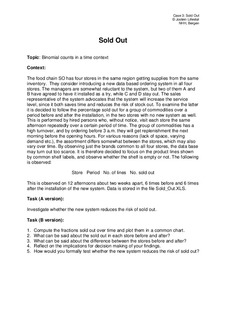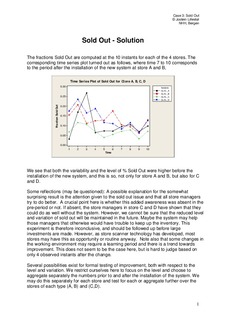| dc.description.abstract | Topic: Binomial counts in a time context
Context:
The food chain SO has four stores in the same region getting supplies from the same inventory. They consider introducing a new data based ordering system in all four stores. The managers are somewhat reluctant to the system, but two of them A and B have agreed to have it installed as a try, while C and D stay out. The sales representative of the system advocates that the system will increase the service level, since it both saves time and reduces the risk of stock out. To examine the latter it is decided to follow the percentage sold out for a group of commodities over a period before and after the installation, in the two stores with no new system as well. This is performed by hired persons who, without notice, visit each store the same afternoon repeatedly over a certain period of time. The group of commodities has a high turnover, and by ordering before 3 a.m. they will get replenishment the next morning before the opening hours. For various reasons (lack of space, varying demand etc.), the assortment differs somewhat between the stores, which may also vary over time. By observing just the brands common to all four stores, the data base may turn out too scarce. It is therefore decided to focus on the product lines shown by common shelf labels, and observe whether the shelf is empty or not. The following is observed:
Store Period No. of lines No. sold out
This is observed on 12 afternoons about two weeks apart, 6 times before and 6 times after the installation of the new system. Data is stored in the file Sold¬_Out.XLS.
Task (A version):
Investigate whether the new system reduces the risk of sold out.
Task (B version):
1. Compute the fractions sold out over time and plot them in a common chart.
2. What can be said about the sold out in each store before and after?
3. What can be said about the difference between the stores before and after?
4. Reflect on the implications for decision making of your findings.
5. How would you formally test whether the new system reduces the risk of sold out? | nb_NO |


